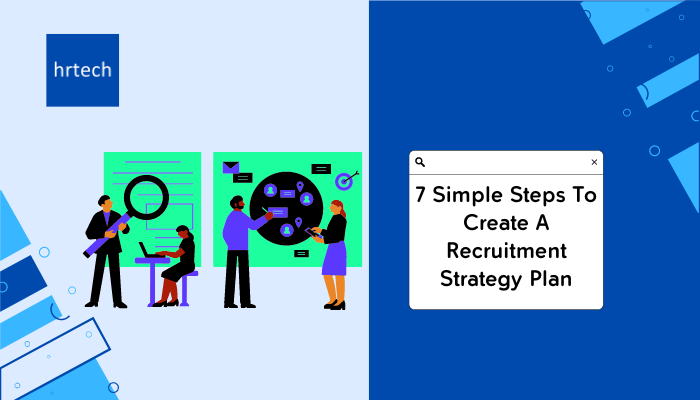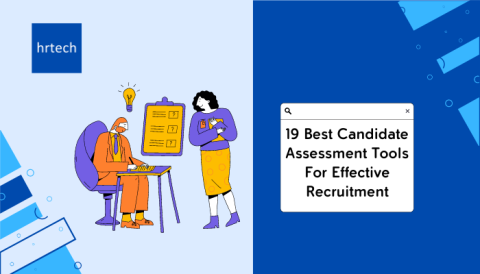Creating a successful recruitment strategy plan can feel overwhelming at first.
Where do you start?
How do you ensure that it’s effective and efficient?
In this guide, we break down the entire process into 7 simple steps so that you can easily develop a recruitment strategy that actually works for you.
Ready to dive in? Let’s go!
What Is A Recruitment Strategy Plan?
A recruitment strategy plan is a roadmap that organizes your hiring process.
It helps you find the right people for your company’s open roles.
This plan covers everything from defining the job requirements to making the final job offer. It ensures that your hiring aligns with your overall business goals.
A well-crafted recruitment strategy plan can save you time and money. It simplifies your hiring efforts and attracts top talent to your organization.
What Things To Have In A Recruitment Strategy Plan?
1. Clear Job Descriptions:
Start by creating detailed job descriptions for each role. Outline the key responsibilities, required skills, and desired qualifications. This helps you attract the most suitable candidates.
2. Ideal Candidate Profiles:
Define your ideal candidate for each position. Consider factors like experience, education, and personality traits. This profile serves as a benchmark when evaluating applicants.
3. Recruitment Channels:
Decide where you’ll post your job openings. This could include job boards, social media, or employee referrals. Choose channels that are most likely to reach your target candidates.
3. Selection Process:
Plan your selection steps, such as resume screening, interviews, and assessments. Establish clear criteria for evaluating candidates at each stage.
4. Hiring Timeline:
Set a timeline for your recruitment process. Determine key dates for posting jobs, conducting interviews, and making hiring decisions. This keeps your efforts on track.
5. Onboarding Plan:
Create a complete onboarding plan for new hires. This should cover orientation, training, and early performance goals. Effective onboarding sets your new employees up for success.
6. Metrics And Tracking:
Define metrics to measure the success of your recruitment strategy. Track factors like time-to-hire, candidate quality, and retention rates. Use this data to refine your approach over time.
Steps To Create A Successful Recruitment Strategy Plan
1. Analyze The Requirement
The first step in creating a successful recruitment strategy plan is to analyze the job requirements thoroughly. This process usually takes about two weeks and involves several key activities.
Start by setting up meeting sessions with the hiring manager, recruiter, and other relevant key decision makers.
During this meeting:
- Review the position’s needs in detail.
- Discuss the specific skills, experience, and qualifications required for the role.
- Consider both the must-have and nice-to-have qualities you’re looking for in a candidate.
Identify any additional individuals who should be involved in the hiring process.
This may include team members who will work closely with the new hire or subject matter experts who can provide insights into the role’s technical requirements.
Did you know that at hrtech, we offer specialized certification programs and courses that help HR professionals to upskill themselves? Check out now to learn more.
2. Review Policies And Job Post Details
Once you understand the position’s requirements, you should review your company’s hiring policies and craft the job post. This process typically takes about two weeks. Start by reviewing any relevant HR policies that may impact the hiring process.
This includes guidelines around diversity and inclusion, equal opportunity employment, and any specific requirements for the role, such as background checks or certifications. Next, prepare the job post details. This is your opportunity to sell the position to potential candidates. Start with a clear and concise job title that accurately reflects the role.
Then, craft a job description that highlights the position’s key responsibilities, required qualifications, and any preferred skills or experience. Be sure to prioritize the position’s needs, focusing on the must-have qualifications first.
Avoid listing excessive requirements that could prevent qualified candidates from applying. Instead, emphasize the most important skills and experiences needed for success in the role.
In addition to the job requirements, highlight the benefits of working for your organization. Share details about your company culture, mission, and values.
Describe the team the new hire will be joining and the impact they’ll have on the organization. Finally, work with your hiring team to develop a bias management strategy. Discuss ways to identify and resolve any potential biases that may arise during the recruitment process.
This could include using inclusive language in the job post, setting specific well-defined criteria for evaluating candidates, and ensuring a diverse interview panel.
3. Set Recruitment Goals
Setting clear recruitment goals is an important part of creating a successful hiring plan. These goals should include both short-term and long-term objectives.
Short-term goals might focus on filling current job openings within a specific timeframe, such as hiring 5 new sales representatives within the next 3 months.
Long-term goals, on the other hand, might focus on bigger-picture objectives like improving diversity in leadership positions or reducing overall hiring costs by 10% over the next year.
When setting these goals, it’s crucial to establish realistic timelines for each step of the recruitment process.
For example, you might allow 2 weeks for job posting and application collection, 3 weeks for initial screenings and interviews, and 1 week for final decision-making and offer extension.
Pro-Tip: Ensure that your recruitment goals align with your overall business goals and current market trends. For instance, if your company is expanding into a new market, your hiring goals might focus on recruiting candidates with specific language skills or cultural knowledge.
4. Craft An Effective Candidate Sourcing Strategy
Once you have your recruitment goals in place, it’s time to develop a plan for sourcing and engaging top candidates.
This involves identifying the best channels and methods for reaching your target talent pool.
One of the most effective sourcing strategies is to use a mix of different channels. This might include:
- Employee referrals – Encourage your current staff to recommend qualified friends or former colleagues. Employee referrals often lead to faster hires, better job fit, and higher retention rates.
- Job boards – Post your open positions on popular job search websites like Indeed, Monster, or industry-specific boards to reach a wide audience of active job seekers.
- Social media – Use social platforms like LinkedIn, Facebook, and Twitter to share job postings, engage with potential candidates, and showcase your employer brand.
- Professional networks – Attend industry conferences, join relevant associations, and participate in networking events to connect with professionals in your field.
- University recruiting – Partner with colleges and universities to recruit promising new graduates, or interns.
The key benefits of using a diversified sourcing strategy include:
- Reaching a wider pool of qualified candidates.
- Attracting passive job seekers who may not be actively looking for new opportunities.
- Building a strong talent pool for future hiring needs.
- Reducing dependence on any single sourcing channel.
For example, let’s say you’re looking to fill a specialized engineering role. In addition to posting the job on traditional boards, as an effective recruitment strategy you could also:
- Reach out to your current engineering team for referrals.
- Search for candidates with relevant skills and experience on LinkedIn.
- Attend local tech meetups or conferences to network with potential hires.
- Contact engineering departments at top universities to promote the opportunity.
5. Build A Well-Structured Screening And Evaluation Process
A well-structured screening and evaluation process is key to identifying the best candidates for your open positions.
This process should be fair, consistent, and aligned with your recruitment goals.
Start by creating a clear set of criteria for evaluating resumes and applications. This might include minimum qualifications, desired skills and experience, and key competencies.
Use these criteria to quickly screen out candidates who don’t meet your basic requirements.
For candidates who pass the initial screening, use additional assessment tools to evaluate their fit for the role. This could include:
- Skills tests or work samples to assess technical abilities.
- Personality or behavioral assessments to analyze work style and cultural fit.
- Phone or video screenings to get a better sense of communication skills and experience.
Pro-Tip: Establishing a consistent evaluation process for all candidates is also important. This might involve using standardized interview questions, rating scales, or scorecards to assess each candidate’s qualifications and fit.
A consistent process helps reduce bias and ensures that all candidates are evaluated fairly.
6. Interview And Candidate Selection
Once you’ve identified your top candidates through the screening process, it’s time for interviews and the final selection.
- Start by finalizing the list of candidates you want to interview. Aim to include a diverse mix of applicants with different backgrounds and experiences.
- Next, determine your interview panel and procedures. Your panel might include the hiring manager, team members, and HR representatives.
- Decide on the format of the interviews (e.g., in-person, video, or phone) and the types of questions you’ll ask.
Once your interviews are scheduled, make sure to coordinate all the necessary details. This includes sending candidates the time, location, and any other relevant information.
After the interviews are complete, gather feedback from the panel and discuss the top candidates. You may want to conduct reference checks on your finalists to verify their experience and qualifications.
When you’re ready to make a decision, extend a job offer to your chosen candidate. Be sure to communicate the details of the offer, including salary, benefits, and start date.
7. Onboarding The Selected Candidates
The final step in your recruitment strategy plan is to create an effective onboarding process for your new hires.
Onboarding is more than just paperwork and orientation – it’s about setting your new employees up for long-term success within your company.
One way to ensure a smooth onboarding process is to create a detailed plan in advance. This plan should cover the new hire’s first day, week, and month on the job.
Some key elements to include in your onboarding plan:
- A welcome package with information about the company, benefits, and policies.
- A clear schedule for the first week, including any necessary training sessions.
- Introductions to key team members of the company.
- Regular check-ins with the manager to discuss progress and any challenges.
- Opportunities for the new hire to socialize and build relationships with colleagues.
For example, you might schedule a team lunch on the new hire’s first day to help them feel welcomed. During their first week, you could assign them a buddy or mentor to answer questions and provide guidance.
And throughout their first month, you might set up weekly one-on-one meetings with their manager to discuss their progress and goals.
Check out this article on onboarding new employees for a step-by-step guidance on developing an effective onboarding process, along with a checklist.
Recruitment Strategy Plan Implementation Tips
Creating a successful recruitment strategy plan is just the first step – the real challenge is putting that plan into action.
Here are top 7 tips that’ll help you implement your recruitment strategy effectively:
1. Develop A Hiring Plan And Recruitment Calendar
Create a detailed hiring plan and calendar to keep your recruitment efforts organized and on track. This should include:
- The number of hires needed for each role and department
- Target start dates for each position
- Key milestones in the recruitment process (e.g., job posting dates, interview timelines)
- Budgets for recruitment activities (e.g., job board fees, recruitment events)
Having a clear plan and timeline helps ensure that everyone involved in the hiring process is aligned and working towards the same goals.
2. Writing A Clear And Appealing Job Description
Your job descriptions are often the first point of contact between your company and potential candidates.
To attract the right talent, your job descriptions should be:
- Clear and to-the-point, avoiding jargon or unclear language.
- Focused on the key requirements and responsibilities of the role.
- Highlight the unique benefits and opportunities of the position.
- Optimized for search engines, including relevant keywords.
Well-written job descriptions can help you attract a higher quality and quantity of applicants, making your recruitment efforts more effective.
3. Choosing The Right Tools And Technology
To manage your recruitment process efficiently, it’s important to have the right tools and technology in place. This can include:
- Applicant tracking systems (ATS) to manage resumes and applications
- Video interviewing platforms for remote candidate screening
- Candidate relationship management (CRM) tools to engage and nurture talent pools
- Background check and reference check software
- Onboarding and HR management systems
By investing in the right technology, you can simplify your recruitment process, reduce manual work, and create a better experience for both candidates and hiring teams.
4. Define Your Selection Criteria And Process
To ensure a fair and consistent evaluation of candidates, clearly define your selection criteria and process upfront. This should include:
- The specific skills, experience, and qualifications required for each role
- The stages of the selection process (e.g., resume screening, phone interviews, in-person interviews, assessments)
- The criteria for evaluating candidates at each stage
- The members of the interview panel and their respective roles
With a structured and standardized selection process, you can reduce bias and make more objective hiring decisions.
5. Measure The Results And Enhance Your Process
To continually improve your recruitment strategy, tracking and measuring your results is important.
Some key metrics to monitor include:
- Time to fill – The average number of days from job posting to accepted offer.
- Cost per hire – The total cost of recruiting for a position, including advertising, agency fees, and staff time.
- Applicant quality – The percentage of applicants who meet the minimum job requirements.
- Candidate experience – Feedback from candidates on their experience with your recruitment process.
- New hire retention – The percentage of new hires who stay with the company for a defined period (e.g., one year).
As you regularly analyze these metrics, you can identify areas for improvement and make data-driven decisions to enhance your recruitment strategy.
Pro-Tip: Check out our marketplace to explore a wide-range of recruitment tools and softwares that can effectively improve your hiring processes.
6. Gather Feedback And Plan For The Future Hiring Needs
Gathering feedback can help you understand what’s working well in your recruitment process and what could be improved.
Consider sending out surveys or conducting interviews with:
- New hires after their first 30, 60, and 90 days on the job
- Candidates who were not selected for the position
- Hiring managers and interview panelists
Ask questions about their experience with the application process, interviews, communication, and overall impression of your company.
Use this feedback to make continuous improvements to your recruitment strategy.
Finally, don’t forget to plan for your future hiring needs. Regularly assess your company’s growth plans and workforce requirements, and adjust your recruitment strategy accordingly.
This includes:
- Building a talent pool for hard-to-fill or high-volume roles.
- Investing in employer branding and recruitment marketing to attract top talent.
- Developing internships to nurture early career talent.
- Expanding your recruitment efforts to new locations or diversity groups.
By staying proactive and adaptable, you can ensure that your recruitment strategy evolves with your business needs and continues to deliver results.
7. Finding The Ideal Candidate
Follows these tips to find the perfect candidate for any open job role:
- Look for candidates who align with your company culture and values, not just those who meet the job requirements.
- Consider potential candidates, such as those with transferable skills or unique experiences.
- Use behavior-based interviewing techniques to assess how candidates have handled real-world situations in the past.
- Look for candidates who are eager to learn and grow within your organization.
- Don’t overlook internal candidates who may be ready for a new challenge or promotion.
Conclusion
In short, creating a successful recruitment strategy plan doesn’t have to be complicated.
As you follow all the 7 simple steps we covered in this guide – from analyzing the recruitment to building an onboarding plan, you can create an effective recruitment strategy plan.
And don’t forget to continually measure your results, gather feedback, and plan for future hiring needs to enhance your recruitment processes.
Want to connect with expert HR professionals who can easily handle high-volume recruiting needs? At hrtech, we also offer talent-on-demand services. Contact us today to learn more.




